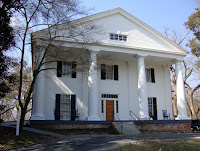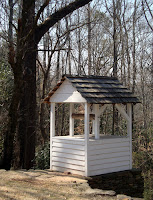 |
| Bulloch Hall |
I'll cover the logistics that are common to all three houses first and then move on to the house that is the topic of this particular post.
Roswell, Georgia, was founded by six families headed by James S. Bulloch (of Bulloch Hall); Barrington King (of Barrington Hall); Archibald Smith (of Smith Plantation); John Dunwoody; Nathan A. Pratt; and Elizabeth King Hand.
First, each home has a strict photography policy. You may make photographs of the exterior of the home only if they are for personal use. Photos of the interior are not permitted. Photos for commercial use require a permit (paperwork may be obtained at any of the homes), which costs $100. NOTE: Please do not use photos in this post for publication, anywhere…thank you (for keeping me policy-compliant).
 |
| Bulloch Hall |
A rather unique feature offered at each of the Trilogy homes, one that I like very much, is self-guided "cell phone audio tours" of the homes' grounds. If you arrive after a guided tour starts, this is a wonderful option for exploring the grounds while waiting for the on-the-hour guided tour.
Signs are posted around the property with the dail-in number and location code. If you explore the grounds after your guided tour of the home, you can pick up a map of the audio tour stops inside the home. NOTE: the audio tour is free, but your applicable personal telephone plan charges will apply (great news for those with unlimited plans).
The audio tour includes information about the tour stop, as well as "letter readings" (letters to and from house residents from years past) at many of the stops.
The Arrival
 |
| Bulloch Hall |
Entering the Bulloch Hall estate is a little different from the others. You first go to an out building where ticketing and the gift shop are located, immediately adjacent to their ample parking lot. If this is your first stop on the Southern Trilogy tour, you can get your ticket for all three homes here.
You can purchase a ticket for a Bulloch Hall-only tour as well, but you save money by buying a Trilogy "Pass," and it does not expire. A docent at each home will sign the Pass to indicate that that portion of the Pass has been redeemed.
 |
| Slaves Quarters |
The Families
One of the founding families of Roswell, Georgia, led by James Stephens Bulloch, a decorated Major in the Texas War for Independence, and his wife Martha Stewart (no relation to today's popular lifestyle guru) were the original habitants of Bulloch Hall.
Traveling with them from Savannah to Roswell was their three year old daughter, Martha "Mittie" Bulloch. In adulthood, Mittie met Theodore "Thee" Roosevelt in 1850 and again in 1853.
 |
| Well |
As it turns out, not one, but two American Presidents have roots traceable to Bulloch Hall. Elliott, another of Mittie's children, was father of Anna Eleanor Roosevelt who married Franklin Delano Roosevelt, her fifth cousin, who went on to become the 32nd President of the United States.
The Home (the tour)
I and a young lady I'd seen going into the 11:00 a.m. tour at Barrington Hall were to be tour mates at Bulloch Hall.
 |
| Bulloch Hall, side |
Designed by Willis Ball, construction on the Greek Revival home was completed in 1839. Huge, thick white columns welcome visitors into the "lofty center entrance hall." There are an equal number of rooms on each side of the house, typical for the era.
The tour started in the entry hallway where Pat explained that the majority of the artifacts in Bulloch Hall are not original to the home, but that the furnishings are authentic to the period.
In the Library and the women's parlor there are, instead of doors, windows, stacked three-high from the floor, that work kind of like doors allowing family and guests out onto the piazza (they didn’t call it a porch).
 |
| Bulloch Hall, rear |
Pat showed us the dining room where Mittie (President Roosevelt's mother) and Theodore ("Thee") were married. Bulloch Hall today reenacts the wedding in a public event every year during the holidays, close to their December 22 anniversary.
We were told by Pat about the house bringing in a designer who specializes in furniture placement of the Bulloch's era. In one of the parlors facing the front of the house, there is a card table that had been placed in a corner near the hallway. The placement was corrected by the expert who put the table next to the front window…for its natural light. The Trilogy management has gone to great lengths to make each of the homes as authentic as possible.
On the tour we were shown a technological marvel…a "mechanical" flyswatter. This is the South and flies can be quite the pests at times. The mechanical flyswatter belonging to the Bulloch's would be used to keep the pests off of food during meals served in the summer months when the doors and windows were often open to allow breezes to cool the house. It was pretty ingenious, really!
Another interesting factoid…children were not allow to dine at the dining room table until they had come of age. Before that, they were fed in another room in the home.
Many of the beds in Bulloch Hall had built-in trundles, so that they could accommodate visitors. Common to the period, visitors would stay for weeks or sometimes months. Having accommodations for said visitors was a sign of welcoming guests and generosity.
On the upper floor is the relatively recently added Museum Room.
 |
| Replica of the original "Teddy" bear |
The article, "Bridesmaid of 87 Recalls Mittie Roosevelt’s Wedding," is an interview with Mrs. William Baker who was Mittie Roosevelt's (mother of President Teddy Roosevelt) best friend and a bridesmaid at her wedding. The article was published June 10, 1923.
President Roosevelt, in 1905, visited Bulloch Hall, his mother’s childhood home. The towns folk were present to hear Teddy speak at multiple locations throughout the day, some of which you can hear on the audio tour.
The Grounds
When visiting, be sure to walk the entire perimeter of the house to see the various stops on the grounds tour.
 |
| Bulloch Hall Gardens |
The Children’s Garden has rabbit topiaries and bird houses, and there are benches and other garden décor throughout.
The reconstructed Slave Quarters, which had been destroyed by fire, are certainly worth a visit. And while you're milling around, a stroll down the Charlie Cothran Memorial Walking Trail will make for a nice distraction, especially during the moderate weather of spring and autumn visits.
The Return
Do I think I'll return to Bulloch Hall anytime soon? I have many friends who are history buffs who have not been and I would welcome another opportunity to explore Bulloch Hall. The tour is one of those that you know there's so much more history than can be told in a single tour, so each tour promises to teach you something new.
Touring The Southern Trilogy: Bulloch Hall
Date toured: Wednesday, February 16, 2011
Location: 180 Bulloch Avenue (directions and map)
Parking: Free onsite parking
Cost: $8 Adults; $6 Children (or $18 for all three homes)
Hours: Monday-Saturday 10:00 a.m. – 3:00 p.m., Sunday 1:00 p.m. - 3:00 p.m. The last tour is at 3:00 p.m.
Events: Magnolia Ball, Saturday, June 11, 2011, and more.
Website: http://www.roswellgov.com/index.aspx?NID=219
Location: 180 Bulloch Avenue (directions and map)
Parking: Free onsite parking
Cost: $8 Adults; $6 Children (or $18 for all three homes)
Hours: Monday-Saturday 10:00 a.m. – 3:00 p.m., Sunday 1:00 p.m. - 3:00 p.m. The last tour is at 3:00 p.m.
Events: Magnolia Ball, Saturday, June 11, 2011, and more.
Website: http://www.roswellgov.com/index.aspx?NID=219


2 comments:
Here's something worth knowing, or at least I think it is. Bulloch Hall appeared in a couple of scenes in Monte Hellman's 1974 film Cockfighter, starring Warren Oates. The Atlanta Time Machine has a few screen captures.
http://www.atlantatimemachine.com/cockfighter/26.htm
Apologies if you knew this already and deliberately omitted it for reasons of taste.
@Greg - Thank you for the additional information. I did not know about the Hollywood connection. They were lucky to have such an amazing home to serve as a set. Thanks again!
Post a Comment